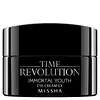What's inside
What's inside
 Key Ingredients
Key Ingredients

 Benefits
Benefits

 Concerns
Concerns

 Ingredients Side-by-side
Ingredients Side-by-side

Melaleuca Alternifolia Leaf Oil
AntioxidantWater
Skin ConditioningGlycerin
HumectantCamellia Sinensis Leaf Extract
Antimicrobial1,2-Hexanediol
Skin ConditioningEthylhexyl Palmitate
EmollientCetearyl Alcohol
EmollientHelianthus Annuus Seed Oil
EmollientCetearyl Olivate
Sorbitan Olivate
EmulsifyingCanola Oil
EmollientCoco-Caprylate/Caprate
EmollientButylene Glycol
HumectantBeeswax
Emulsion StabilisingVitis Vinifera Seed Oil
EmollientPolyglyceryl-6 Distearate
EmulsifyingPrunus Armeniaca Kernel Oil
MaskingPalmitic Acid
EmollientArginine
MaskingCarbomer
Emulsion StabilisingStearic Acid
CleansingXylitylglucoside
HumectantAnhydroxylitol
HumectantJojoba Esters
EmollientDipotassium Glycyrrhizate
HumectantParfum
MaskingXanthan Gum
EmulsifyingMacadamia Ternifolia Seed Oil
EmollientHydrogenated Olive Oil Unsaponifiables
EmollientXylitol
HumectantAdenosine
Skin ConditioningCetyl Alcohol
EmollientPolyglyceryl-3 Beeswax
EmulsifyingLavandula Angustifolia Flower Extract
CleansingMalt Extract
Skin ProtectingSodium Hyaluronate
HumectantGlucose
HumectantDisodium EDTA
Argania Spinosa Kernel Oil
EmollientTremella Fuciformis Sporocarp Extract
AntioxidantCaprylyl Glycol
EmollientEthylhexylglycerin
Skin ConditioningHydrolyzed Hyaluronic Acid
HumectantPunica Granatum Extract
AstringentArachidic Acid
CleansingPalmitoyl Tetrapeptide-7
Skin ConditioningAcetyl Hexapeptide-8
HumectantMyristic Acid
CleansingOleic Acid
EmollientLauric Acid
CleansingSodium Acetylated Hyaluronate
HumectantPalmitoyl Tripeptide-1
Skin ConditioningMelaleuca Alternifolia Leaf Oil, Water, Glycerin, Camellia Sinensis Leaf Extract, 1,2-Hexanediol, Ethylhexyl Palmitate, Cetearyl Alcohol, Helianthus Annuus Seed Oil, Cetearyl Olivate, Sorbitan Olivate, Canola Oil, Coco-Caprylate/Caprate, Butylene Glycol, Beeswax, Vitis Vinifera Seed Oil, Polyglyceryl-6 Distearate, Prunus Armeniaca Kernel Oil, Palmitic Acid, Arginine, Carbomer, Stearic Acid, Xylitylglucoside, Anhydroxylitol, Jojoba Esters, Dipotassium Glycyrrhizate, Parfum, Xanthan Gum, Macadamia Ternifolia Seed Oil, Hydrogenated Olive Oil Unsaponifiables, Xylitol, Adenosine, Cetyl Alcohol, Polyglyceryl-3 Beeswax, Lavandula Angustifolia Flower Extract, Malt Extract, Sodium Hyaluronate, Glucose, Disodium EDTA, Argania Spinosa Kernel Oil, Tremella Fuciformis Sporocarp Extract, Caprylyl Glycol, Ethylhexylglycerin, Hydrolyzed Hyaluronic Acid, Punica Granatum Extract, Arachidic Acid, Palmitoyl Tetrapeptide-7, Acetyl Hexapeptide-8, Myristic Acid, Oleic Acid, Lauric Acid, Sodium Acetylated Hyaluronate, Palmitoyl Tripeptide-1
Betula Alba Juice
AstringentCyclomethicone
EmollientDimethicone/Vinyl Dimethicone Crosspolymer
Skin ConditioningGlycerin
HumectantButylene Glycol
HumectantDipropylene Glycol
HumectantNiacinamide
SmoothingSilica
Abrasive1,2-Hexanediol
Skin ConditioningAcetyl Tetrapeptide-5
HumectantSh-Decapeptide-9
Skin ConditioningSodium Cocoyl Alaninate
Dimethicone
EmollientHydrogenated Lecithin
EmulsifyingCassia Alata Leaf Extract
AstringentAdenosine
Skin ConditioningHydrolyzed Myrtus Communis Leaf Extract
Skin ProtectingResveratrol
AntioxidantXanthophylls
Skin ConditioningAlgin
MaskingPolyglutamic Acid
Skin ConditioningTitanium Dioxide
Cosmetic ColorantPhenoxyethanol
PreservativeBetula Alba Juice, Cyclomethicone, Dimethicone/Vinyl Dimethicone Crosspolymer, Glycerin, Butylene Glycol, Dipropylene Glycol, Niacinamide, Silica, 1,2-Hexanediol, Acetyl Tetrapeptide-5, Sh-Decapeptide-9, Sodium Cocoyl Alaninate, Dimethicone, Hydrogenated Lecithin, Cassia Alata Leaf Extract, Adenosine, Hydrolyzed Myrtus Communis Leaf Extract, Resveratrol, Xanthophylls, Algin, Polyglutamic Acid, Titanium Dioxide, Phenoxyethanol
Ingredients Explained
These ingredients are found in both products.
Ingredients higher up in an ingredient list are typically present in a larger amount.
1,2-Hexanediol is a synthetic liquid and another multi-functional powerhouse.
It is a:
- Humectant, drawing moisture into the skin
- Emollient, helping to soften skin
- Solvent, dispersing and stabilizing formulas
- Preservative booster, enhancing the antimicrobial activity of other preservatives
Adenosine is in every living organism. It is one of four components in nucleic acids that helps store our DNA.
Adenosine has many benefits when used. These benefits include hydrating the skin, smoothing skin, and reducing wrinkles. Once applied, adenosine increases collagen production. It also helps with improving firmness and tissue repair.
Studies have found adenosine may also help with wound healing.
In skincare products, Adenosine is usually derived from yeast.
Learn more about AdenosineButylene Glycol (or BG) is used within cosmetic products for a few different reasons:
Overall, Butylene Glycol is a safe and well-rounded ingredient that works well with other ingredients.
Though this ingredient works well with most skin types, some people with sensitive skin may experience a reaction such as allergic rashes, closed comedones, or itchiness.
Learn more about Butylene GlycolGlycerin is already naturally found in your skin. It helps moisturize and protect your skin.
A study from 2016 found glycerin to be more effective as a humectant than AHAs and hyaluronic acid.
As a humectant, it helps the skin stay hydrated by pulling moisture to your skin. The low molecular weight of glycerin allows it to pull moisture into the deeper layers of your skin.
Hydrated skin improves your skin barrier; Your skin barrier helps protect against irritants and bacteria.
Glycerin has also been found to have antimicrobial and antiviral properties. Due to these properties, glycerin is often used in wound and burn treatments.
In cosmetics, glycerin is usually derived from plants such as soybean or palm. However, it can also be sourced from animals, such as tallow or animal fat.
This ingredient is organic, colorless, odorless, and non-toxic.
Glycerin is the name for this ingredient in American English. British English uses Glycerol/Glycerine.
Learn more about Glycerin